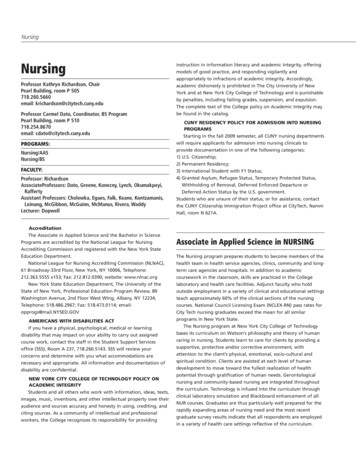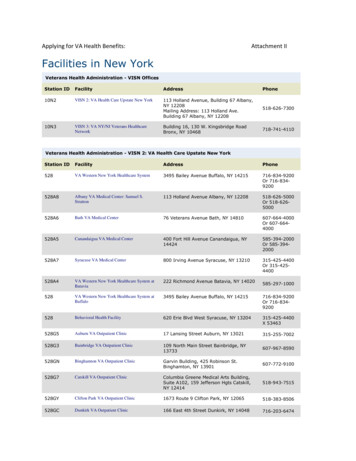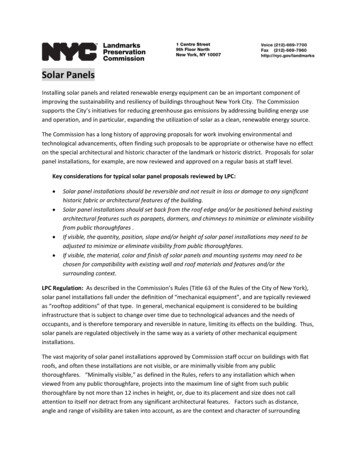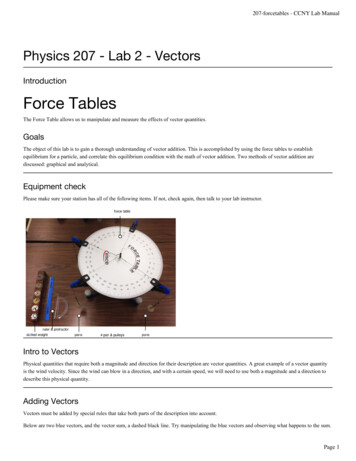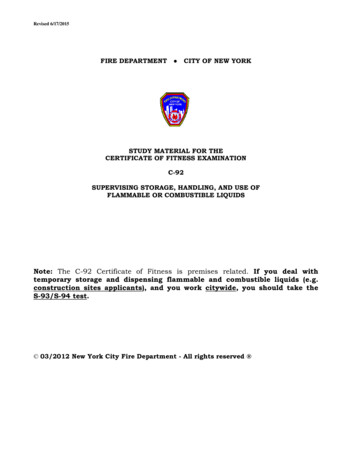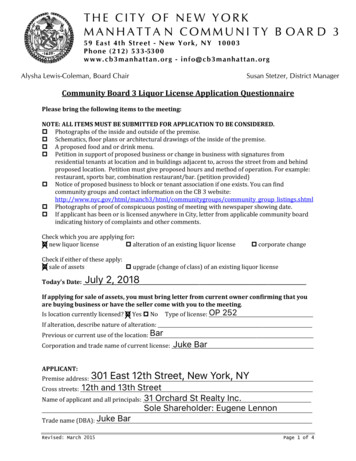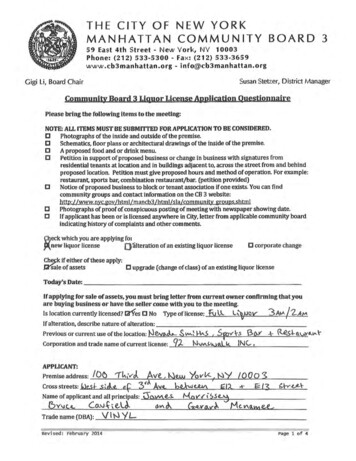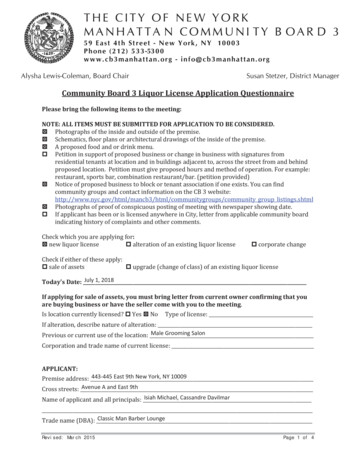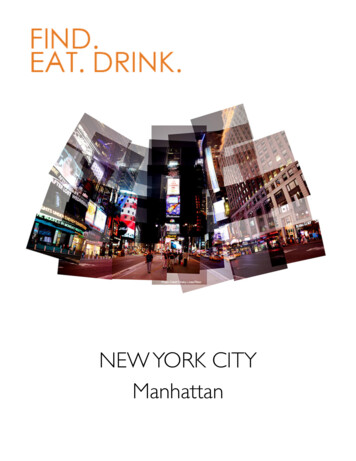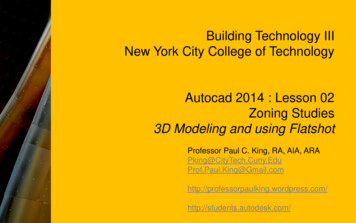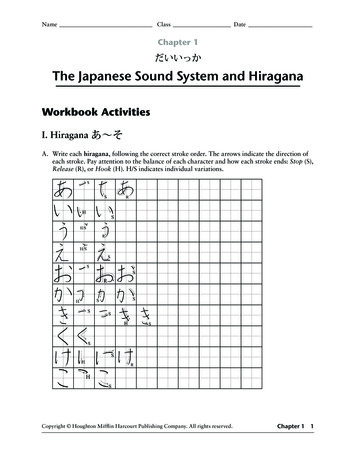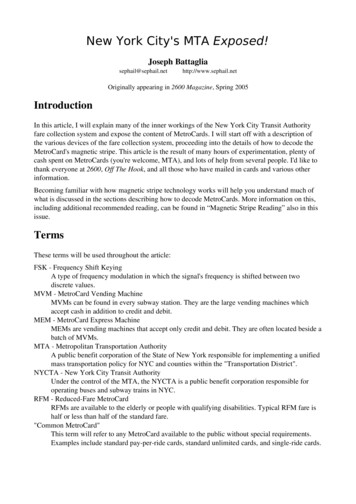
Transcription
New York City's MTA Exposed!Joseph Originally appearing in 2600 Magazine, Spring 2005IntroductionIn this article, I will explain many of the inner workings of the New York City Transit Authorityfare collection system and expose the content of MetroCards. I will start off with a description ofthe various devices of the fare collection system, proceeding into the details of how to decode theMetroCard's magnetic stripe. This article is the result of many hours of experimentation, plenty ofcash spent on MetroCards (you're welcome, MTA), and lots of help from several people. I'd like tothank everyone at 2600, Off The Hook, and all those who have mailed in cards and various otherinformation.Becoming familiar with how magnetic stripe technology works will help you understand much ofwhat is discussed in the sections describing how to decode MetroCards. More information on this,including additional recommended reading, can be found in “Magnetic Stripe Reading” also in thisissue.TermsThese terms will be used throughout the article:FSK Frequency Shift KeyingA type of frequency modulation in which the signal's frequency is shifted between twodiscrete values.MVM MetroCard Vending MachineMVMs can be found in every subway station. They are the large vending machines whichaccept cash in addition to credit and debit.MEM MetroCard Express MachineMEMs are vending machines that accept only credit and debit. They are often located beside abatch of MVMs.MTA Metropolitan Transportation AuthorityA public benefit corporation of the State of New York responsible for implementing a unifiedmass transportation policy for NYC and counties within the "Transportation District".NYCTA New York City Transit AuthorityUnder the control of the MTA, the NYCTA is a public benefit corporation responsible foroperating buses and subway trains in NYC.RFM Reduced Fare MetroCardRFMs are available to the elderly or people with qualifying disabilities. Typical RFM fare ishalf or less than half of the standard fare."Common MetroCard"This term will refer to any MetroCard available to the public without special requirements.Examples include standard pay per ride cards, standard unlimited cards, and single ride cards.
"Special MetroCard"This term will refer to any MetroCard not available to the general public. Examples includereduced fare cards, student cards, and employee cards."Single Track MetroCard"This term will refer to any MetroCard that has a one track magnetic stripe (although there isno visible difference between the stripes of these cards and the stripes of two track cards). Thefollowing types of cards are single track: Single Ride and Bus Transfer MetroCards."Dual Track MetroCard"This term will refer to all MetroCards with the exception of the single track MetroCardsmentioned above. The following types of cards are some examples of dual track cards: pay per ride, pre valued, unlimited, and reduced fare."Passback period"This term will refer to the time period before an access device will allow you to use anunlimited card again after swiping it. During this period, the devices generally respond withthe message "JUST USED"."Standard cards" and "standard readers"These terms will refer to cards containing a magnetic stripe (credit, banking, etc) or readers ofthese cards that conform to the standards set forth in any or all of the following ISOspecifications: 7810, 7811, 7813, and 4909.Cubic Transportation SystemsThe fare collection system the MTA uses is developed by Cubic Transportation Systems, asubsidiary of Cubic Corporation. The patents I found to be related to the current New York Citysystem filed by Cubic Corporation are as follows: 4,877,179 FAREBOX SECURITY DEVICE5,056,261 TURNSTILE SYSTEM5,072,543 TURNSTILE MECHANISM5,191,195 FARE CARD READ WRITER WHICH OVERWRITES OLDEST ORINVALID DATA5,215,383 TICKET STOCK AND TICKET DISPENSER5,298,726 FARE CARD READ WRITER WHICH OVERWRITES OLDEST ORINVALID DATA5,333,410 CONTROLLABLE BARRIER SYSTEM FOR PREVENTING UNPAIDADMISSION TO A FEE PAID AREA5,574,441 MASS TRANSIT INDUCTIVE DATA COMMUNICATION SYSTEM5,612,684 MASS TRANSIT INDUCTIVE DATA COMMUNICATION SYSTEM6,595,416 SYSTEM FOR RAPIDLY DISPENSING AND ADDING VALUE TO FARECARDS6,655,587 CUSTOMER ADMINISTERED AUTOLOAD6,789,736 DISTRIBUTED ARCHITECTURE FOR MAGNETIC FARE CARDPROCESSINGServicing, apart from routine collection of fares, on MTA equipment seems to be done by Cubicemployees, not the MTA.
The MetroCard SystemAt the core of the MTA fare collection system is the MetroCard. Preceded by a token based system,the MetroCard is now used for every aspect of fare collection and allows for fare options that wouldnever have been previously possible (e.g., Employee, Reduced Fare, and Student MetroCards).MetroCards can currently be purchased at MVMs, MEMs, token booths, and various merchantsthroughout the New York City area. I will categorize the MetroCard access devices into two types:reading devices and fare collection devices. Both of these devices are networked in a complexsystem which allows the MTA, within minutes, to have up to date information on every card thathas been issued. This also allows them to disable any card at will. The hierarchy of the network isshown below (as described in patent 6,789,736).The physical characteristics of MetroCards follow those of standard cards (see Terms) almostexactly, but are one third the thickness. They have a diagonal notch cut out in the upper right handcorner 3 1/8" from the left and 5/16" from the top of the card. Additionally, they have a 1/8"diameter hole, with its center 1/4" from the left and 5/16" from the top of the card, which is used toaid machines that suck your card in (bus fare boxes, MEMs/MVMs, handicapped entry/exitmachines, etc.).
Vending MachinesMEMs and MVMs are located throughout the subway system. They allow you to purchase or refillvarious common MetroCards with either cash or a credit card. RFMs can't be purchased at machinesbut can be refilled. On the front of the MEM or MVM is a tag with the machine's unique IDnumber.The BIOS System Configuration screen from an MEM looks like this:AMIBIOS System Configuration (C) 1985-1997, American Megatrends Inc.,Main ProcessorMath ProcessorFloppy Drive A:Floppy Drive B:AMIBIOS DateProcessor Clock::::::Celeron(tm)Built-InNoneNone07/15/95300A MHzBase Memory SizeExt. Memory SizeDisplay TypeSerial Port(s)Parallel Port(s)External CacheATA(PI) Device(s) TypeSizePrimary Master5729MBPCIPCIPCIPCI: Hard DiskDevices:Onboard Bridge DeviceOnboard IDEOnboard 8KB,Enabled32BitModeOnBlockMode16SecPIOMode4PCI Onboard USB Controller, IRQ11PCI Onboard Ethernet, IRQ15FPGA ver. C, Base Address: 500hBSP CPU.Microcode OKI have no reason to believe that the MVM hardware is any different.ReceiptsReceipts can be obtained from MEM and MVM machines by answering "yes" when prompted.They possess a lot of information about the MEM/MVM, subway station, and card. You can matcha receipt to a card by comparing the serial numbers. Let's take a look at some samples:MVM RECEIPTMVM RECEIPTMTA NYC TRANSITASTOR PLACENEW YORK CITY NYMVM #: 0545(R219MEM RECEIPTMTA NYC TRANSITMTA NYC TRANSITNASSAU AV & MANHATTAN AV 14TH STREET & 6TH AVENUENEW YORK CITY NYNEW YORK CITY NY0701)MVM #: 1738(N408A0500) MEM #: 5383(N513 0400)Sun 14 Nov 04 21:28Mon 04 Oct 04 14:22Wed 17 Nov 04 12:14Trans: Sale OKPayment Mode: CashAmount: 7.00Card Value: 0.00Change Due: 3.00Trans: Sale OKPayment Mode: CreditAmount: 21.00Card Value: 0.00Trans: Add Time OKAmount: 10.50Initial Type:0307-DAY RFM UNLIMITEDTime Added: 0307-DAY RFM UNLIMITEDSerial #:1059909877Type: 0231-DAY UNLIMITEDQuestions?Call (212) METROCARDCredit Card #: XX5346Auth#: 000008Ref #: 060615762129Serial #:1027066848Type: 0247-DAY UNLIMITEDQuestions?Call (212) METROCARDATM Card #: XX0952Auth#: 760346Ref #: 029089559668Serial #:0987218036Questions?Call (212) METROCARD
Most of the information on the receipt is fairly obvious, but notice the line that begins with "MEM#" or "MVM #". The first four digits correspond to the actual MEM or MVM ID number as foundon the machine. The next letter and following three digits inside the parenthesis correspond to theclosest token booth. This ID can also be found on the booth itself. The meaning of the next fourdigits is currently unknown. However, they are unique to each machine that has the same booth ID,but are not unique among machines with different booth IDs. They seem to simply be a unique IDfor each MEM/MVM in the station, possibly grouped by location. See "MEM/MVMs" for a table.Now look to the bottom of the receipt. The line that begins with "Type:" (or "Initial Type:" if anRFM is being refilled) gives the numerical card subtype value followed by a description of the typeon the following line.Receipts purchased with a credit card contain additional fields that allow the MTA to verify thecredit card holder in the case that he/she decides to lose the MetroCard.TurnstilesThe use of a turnstile is the most common way to enter the subway. Entry is granted by swiping avalid MetroCard through the reader/writer located on the outside of each turnstile. Once swiped, theLCD display on the turnstile will display a message. Some common messages:GOMessage displayed for unlimited MetroCardsGO1 RIDE LEFTMessage displayed for Student MetroCards, where '1' is the number of rides left for the day.JUST USEDThe passback period for the unlimited MetroCard is not upGO1 XFER OKMessage displayed when transferring from a bus.Above the LCD there are a series of round indicators. Of these, one has an arrow pointing in thedirection of the turnstile in which you would enter after paying your fare, and another reads "No"and a do not enter bar which, when lit, indicates that the turnstile is not active. After paying yourfare, another indicator below the green arrow lights to indicate that you may proceed through theturnstile without smashing your groin into the arm.Above those, there are three horizontal bar indicators contained within a rectangular cutout. When aReduced Fare MetroCard is swiped, the top indicator (red) will light. When a Student MetroCard isswiped, the middle indicator (yellow) will light. When an Employee MetroCard is swiped, thebottom indicator (the color of which I'm unsure of) will light. These indicators are present on bothsides of the turnstiles and they allow transit cops, many of whom are undercover, to monitor thetypes of cards being used by riders. This helps detect, for example, when Student MetroCards arebeing used at times when school is not in session or when an obvious misuse of an Employee orReduced Fare MetroCard occurs.
Reading MetroCardsMetroCards are relatively difficult to read. You will not be able to read them with off the shelfmagnetic stripe readers, so please don't waste your money. The reason for this is not that the formatis different; MetroCards use Aiken Biphase (also known as frequency shift keying (FSK)) just likestandard cards. However, the hardware that ships with these readers is designed for a completelydifferent (and well documented) specification. They require many "clocking bits," which consist ofa string of zero bits at the beginning of the stripe to aid in setting a reference frequency fordecoding. Additionally, most readers also look for a standard start and end sentinel that exists onstandard cards to denote the start of a particular track. On top of that, characters on these cards aredefined as either four or six bit blocks (depending on the track) and contain a longitudinalredundancy check (LRC) character after the end sentinel to verify data integrity. Needless to say,MetroCards don't have any of these properties and contain fields of arbitrary length; thus, anothermethod of reading and decoding is required.Fortunately, magnetic heads are everywhere (e.g., cassette tape players) and the output frommagnetic heads when passed over a magnetic stripe consists of voltage spikes in the audiblefrequency range. Since sound cards are excellent A/D converters for this range of input and arereadily available and very cheap, we can use the microphone input interfaced to a magnetic head forthe purpose of creating our own reader (for a lot less than the MTA is paying, I'm sure!). See thearticle “Magnetic Stripe Reading” in this issue for more details.For the same reason that reading was initially difficult, writing to MetroCards is extremely difficult,and is still a work in progress which will not be discussed in this article. A technique similar to thatof the decoder (in reverse) can be used to write to cards, although it is much more difficult toimplement and obviously requires more equipment than just a sound card and a magnetic head. Forthose of you who realize how this can be done and have the ability to build the equipment, kudos,but keep in mind the ramifications of being caught using a card you wrote to yourself. Modifyingthe data on cards does work. But the MetroCard system is very complex and allows for thesurveillance of this sort of activity. The goal of this project is to learn how the system works, how itcan be theoretically defeated, but certainly not to get stuck in prison.Apart from these difficulties, MetroCard tracks are defined as follows: Dual Track MetroCards havetwo tracks one track being twice the width of the other and will be referred to as track 1 2 andtrack 3; Paper MetroCards have one track which will be referred to as track 1 2. These track names(as I refer to them) correspond to the same track fields that have been established by ISO 7811.Decoding Dual Track MetroCards Track 3Track 3 on dual track MetroCards contains static data. It is written when the card is produced andthe serial number is printed on the back, and is not written to thereafter by any machine. Some datafound on this track can also be found by l
system filed by Cubic Corporation are as follows: . on the following line. Receipts purchased with a credit card contain additional fields that allow the MTA to verify the credit card holder in the case that he/she decides to lose the MetroCard. Turnstiles The use of a turnstile is the most common way to enter the subway. Entry is granted by swiping a valid MetroCard through the reader .

